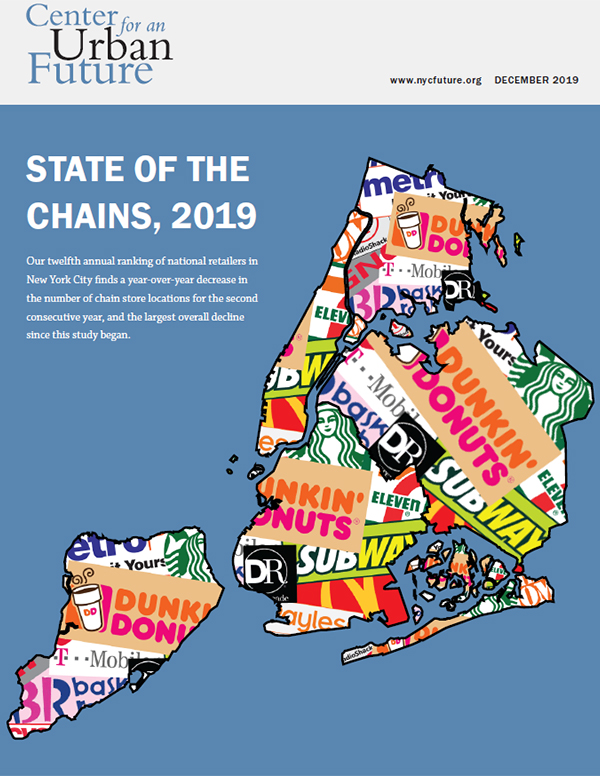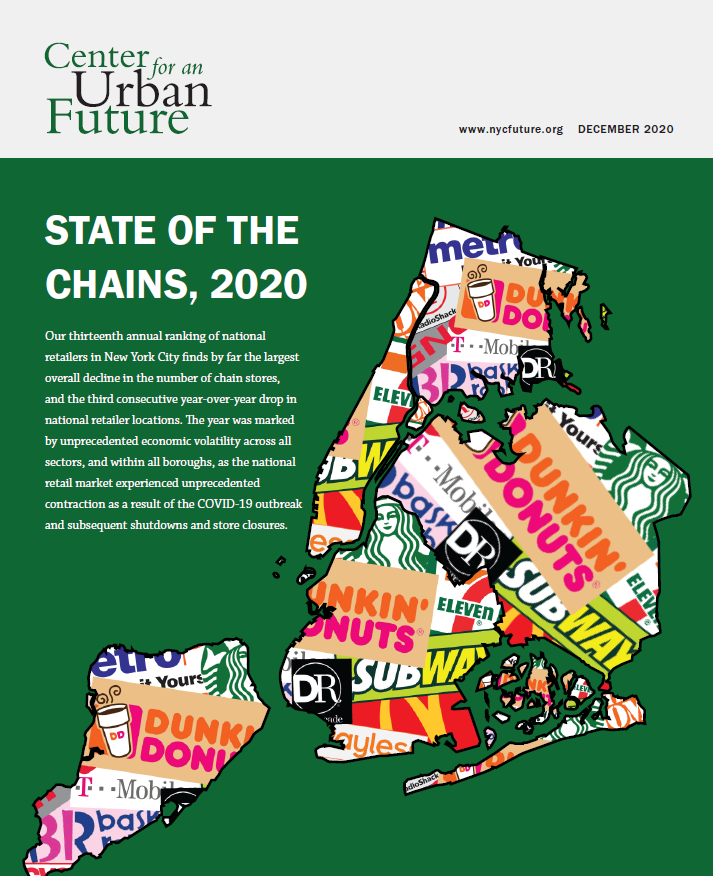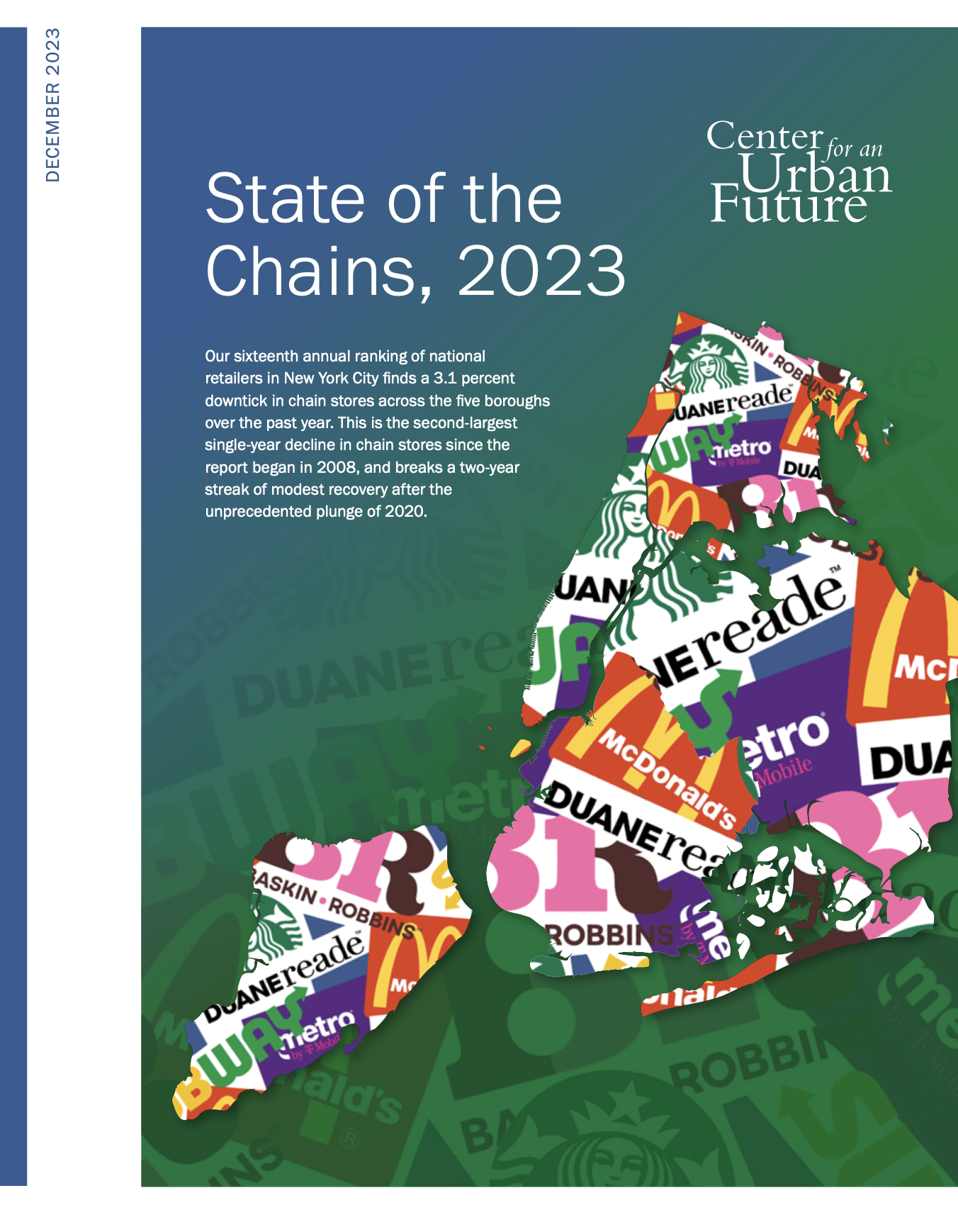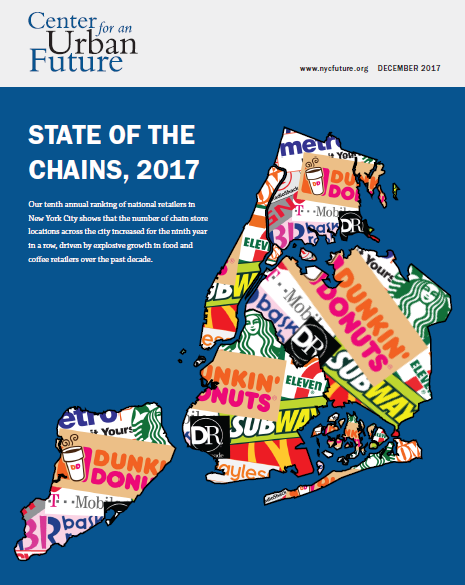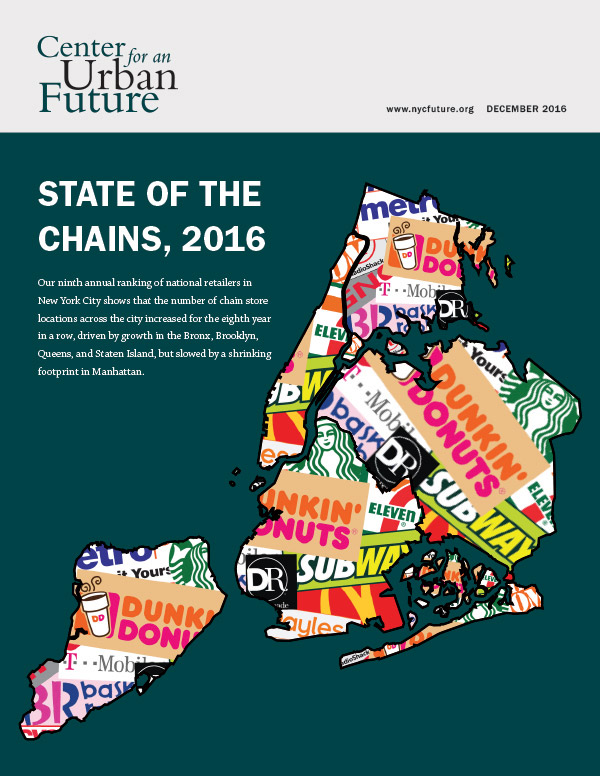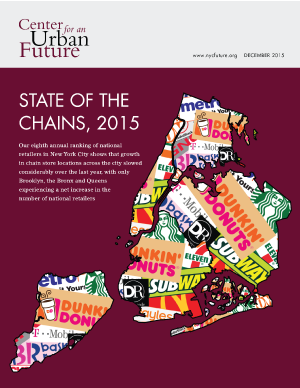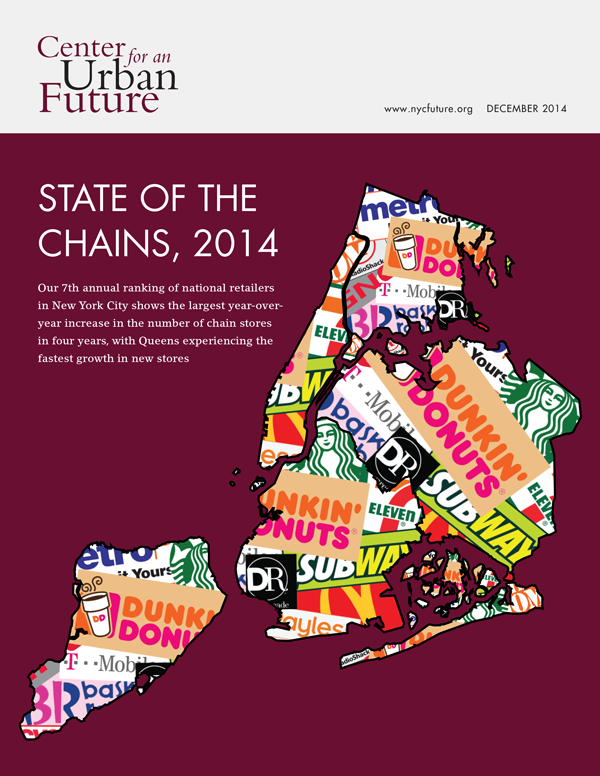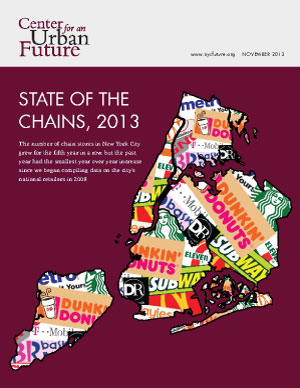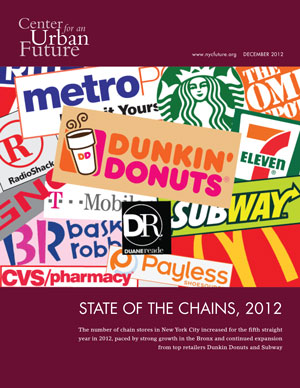Click here to download the full report.
The number of chain stores in New York City declined by 0.3 percent over the past year, marking the first year-over-year drop in national retail locations since the Center for an Urban Future began our annual analysis of the city’s chain retailers more than a decade ago.
Our eleventh annual analysis of national retailer locations in New York also finds that a record 124 retailers—37 percent of the 331 national retail companies in our study—reduced their footprint over the past year. This compares to 99 retailers that registered a net gain in stores over the past year, and 108 retailers whose footprints remained unchanged. In fact, the number of retailers reducing stores is up by 91 percent; last year, just 65 of the retailers in our report registered a net decline in stores.
Overall, our analysis shows that the 331 retailers listed in last year’s ranking reduced their total footprint in New York City by 27 store locations, declining from a total of 7,876 stores in 2017 to 7,849 stores in 2018—an 0.3 percent decrease. The slowdown is led by Manhattan, where the number of chain store locations shrank by 2.3 percent—the sharpest single year decline to date. In every other borough, the number of chain stores increased again this year.
The pullback was most pronounced among merchandise retailers that are struggling to compete in an age of e-commerce, with broad-based declines among retailers selling clothing, shoes, accessories, jewelry, and cosmetics.
- Clothing retailers with declines over the past year include: BCBG Max Azria (a loss of 7 stores), Bolton’s (-6), Aeropostale (-5), Club Monaco (-5), True Religion (-5), Gap (-4), Dr Jays (-4), Thomas Pink ( 3), Bebe (-3), Brooklyn Industries (-3), Armani Exchange (-2), Chico’s (-2), Kenneth Cole (-1), and Banana Republic (-1).
- Shoe companies with declines include: Aerosoles (-13), Nine West (-3), Geox (-3), Fabco Shoes (-3), Rockport (-2), Traffic Shoes (-2), Easy Spirit (-1), Famous Footwear (-1), and Stride Rite (-1).
- Accessories stores with reductions include: Sunglass Hut (-8), Lids (-7), Claire’s (-4), Fossil (-4), Laila Rowe (-2), Solstice Sunglass Boutique (-2), and Coach (-1).
Although more than three dozen national food retailers increased their presence over the past year, there were roughly as many retailers in the food sectors closing stores, with the biggest losses among fast food sandwich shops and ice cream stores. The retailer with the single biggest drop in stores was Subway, which had a massive 103-store decrease in shop locations.
- Food chains with declines include: Subway (-103), McDonalds (-8), Au Bon Pain (-7), ’wichcraft (5), Checkers (-6), Panera Bread (-5), Wingstop (-5), Potbelly Sandwich Shop (-2), Cosi (-2), Quiznos (-2), Hale and Hearty Soups (-2), and Le Pain Quotidien (-2).
- Ice cream stores with declines include: 16 Handles (-4), Tasti D-Lite (-3), Ben & Jerry’s (-2), Häagen-Dazs (-2), Red Mango (-2), and Cold Stone Creamery (-1),
Dunkin Donuts is the biggest national retailer in the city for the tenth year running, with 624 locations, gaining 12 locations since last year. MetroPCS (now called Metro by T-Mobile, but retaining a distinct brand) has 472 locations, up from 444 last year. Subway is still in third place with 330 locations despite having lost 103 locations since last year. Only seven retailers grew by more than 10 locations: AT&T, MetroPCS, Sprint, T-Mobile, Starbucks, Dunkin’ Donuts, and Dollar Tree.
The biggest gains by far were among cellular telephone services locations, which added 129 stores citywide since last year. All five cellphone chains on our list gained locations: AT&T (+58), Metro PCS (+28), Sprint (+26), T-Mobile (+16), and Verizon Wireless (+1). Coffee shops had a net gain of 27 locations, with the growth concentrated in half of the eight coffee chains on the list, Starbucks (+15), Dunkin’ Donuts (+12), Blue Bottle Coffee (+2), and Joe Coffee (+1). There were also considerable gains among chain food retailers, with some surprising increases among traditional fast food restaurants, continued growth by fast casual chains, and sharp gains among bubble tea shops.
- Traditional fast food chain restaurants that added stores include: Burger King (+9), Domino’s Pizza (+7), Taco Bell (+6), Popeyes (+4), Panda Express (+4), Wendy’s (+3), Chick-fil-A (+3), Boston Market (+3), Five Guys (+2), and Golden Krust (+2).
- Fast casual chains increasing their footprint include: Chipotle (+5), Pret A Manger (+5), sweetgreen (+4), Dig Inn (+4), Shake Shack (+4), Bareburger (+2), Fresh & Co (+2), Just Salad (+1), and Chop’t Creative Salad Co. (+1).
- Bubble tea chains that added stores include: Vivi’s Bubble Tea (+5), Gong Cha (+4), and Kung Fu Tea (+3).
A record 18 retailers closed all of their locations since last year: bakery Crumbs Bake Shop; shoe retailers Aerosoles, Nine West, Rockport, Traffic Shoes, Easy Spirit, and Stride Rite; fitness clubs David Barton Gym and Gold’s Gym, electronics retailer Radio Shack; fast food retailers Quiznos, KyoChon, and Chevy’s Fresh Mex; clothing retailers Afaze and DKNY; cosmetics retailer Bare Minerals; toy store Toys ‘R’ Us; and retailer Brookstone.
Retailer trends since last year
For the tenth consecutive year, Dunkin’ Donuts tops our list as the largest national retailer in New York City, with a total of 624 stores, a net increase of 12 stores since 2017. MetroPCS is still the second-largest national retailer in the city, with 472 stores, after gaining 28 stores over the past year. Rounding out the top ten national retailers in New York are Subway (with 330 stores), Starbucks (327), Duane Reade/Walgreens (263), T-Mobile (252), Baskin Robbins (227), McDonald’s (207), Rite Aid (178), and CVS (159).1 There are 15 retailers with at least 100 stores across the city, an increase from 12 last year.
The number of chain stores decreased by 2.3 percent in Manhattan, which amounts to a loss of 67 locations. The other boroughs gained stores; however, Brooklyn and Queens each registered a net gain of just three stores. Among all boroughs, the fastest growth occurred on Staten Island (a 3.2 percent increase, or a gain of 14 stores) followed by the Bronx (a 2.0 percent jump, or an increase of 20 stores).
Starbucks has more stores in Manhattan than any other national retailer, with 227 locations. In Brooklyn, MetroPCS has overtaken Dunkin’ Donuts with 149 locations in the borough to the donut and coffee shop’s 141. This happened last year in the Bronx, where the cell phone retailer now has 104 locations to Dunkin’s 90. In Queens, and on Staten Island, Dunkin’ Donuts retains its lead, with 192 locations and 35 locations, respectively.
Among the large pharmacy chains, Rite Aid is the top pharmacy in the Bronx, Brooklyn, and Queens. Duane Reade/Walgreens has the most locations in Manhattan, and CVS has the top spot on Staten Island. After Dunkin’ Donuts, Subway is the most popular fast-food chain in each of the five boroughs.
Fewer national retailers expanded this year than at any other time over the past 11 years. However, the following retailers did experience significant store growth over the past year:
- AT&T: 118 locations, up from 60 last year and 85 in 2008
- MetroPCS: 472 locations, up from 444 last year and just 7 in 2009
- Sprint: 107 locations, up from 81 last year and just 25 in 2008
- T-Mobile: 252 locations, up from 236 last year and 82 in 2008
- Dunkin’ Donuts: 624 locations, up from 612 last year and 341 in 2008
- Dollar Tree: 86 locations, up from 73 last year and just 10 in 2015
- Trader Joe’s: 12 locations, up from 7 last year and 3 in 2010
- Target: 19 locations, up from 12 last year and 7 in 2008
The following retailers downsized significantly over the past year, but still have a presence in the city:
- Subway: 330 locations, down from 433 last year and a peak of 462 in 2014
- Family Dollar: 61 locations, down from a peak of 79 last year
- Staples: 38 locations, down from 47 last year and a peak of 63 in 2009
- Sunglass Hut: 16 locations, down from 24 last year and a peak of 32 in 2012
- McDonalds: 207 locations, down from 215 last year and a peak of 258 in 2009
- True Religion: 1 location, down from 6 last year and a peak of 7 in 2014
- Curves: 1 location, down from 4 last year and a peak of 47 in 2008
Clothing retailers have had more losses in retail locations than any other category in our analysis. Of the 86 clothing and accessories retailers we analyzed, 32 lost stores and 48 did not add locations. Of the 16 that expanded their footprints, none added more than four locations.
Most national retailers were launched or are headquartered outside of New York City. Nonetheless, a fifth of all chain locations in New York City are outposts of homegrown retailers. In addition, New York City–based national chains are responsible for more than half of all store locations in four different retail categories. Fully 99 percent of chain health club locations belong to New York City–based chains like Equinox and New York Sports Club, as well as 75 percent of pet supply store locations, 69 percent of optical good and optometrist chain locations, 67 percent of juice bars, and 66 percent of chain tea shop locations. In contrast, only 2 percent of chain coffee shop locations belong to national retailers based in New York City, along with 6 percent of ice cream chain locations and 11 percent of fast-food restaurant locations.
Borough Trends
Our report also charts retailer trends within the boroughs. We discovered several interesting trends this year:
- Overall, 174 retailers have more of their stores in Manhattan than any other borough, 59 retailers have more of their stores in Brooklyn, 51 in Queens, 19 in the Bronx, and seven have the most on Staten Island.
- Only 146 out of the 328 national retailers with locations in New York City had at least one location in the Bronx (45 percent) an increase from 133 last year. In comparison, 273 (83 percent) have locations in Manhattan, 211 (64 percent) have locations in Queens, 211 (64 percent) have locations in Brooklyn, and 166 (51 percent) have locations on Staten Island.
- Fifty-four retailers have no locations outside Manhattan, with the largest being Pret a Manger (55 locations), Papyrus (22 locations), and Chop’t (18 locations).
- Five retailers have their only locations in Queens: Puma, FYE, Original Soupman, Curves, and True Religion, each with just one location in the city. Three of the national retailers that had their only locations in Queens last year have closed down this year: Gold’s Gym, Bare Minerals, and Easy Spirit.
- Only two retailers have their only locations on Staten Island: Planet Wings (5 locations) and Helzberg’s Diamonds (1 location). Last year, Build-A-Bear Workshop had its only location on Staten Island, but in the past year the retailer has opened a location in Manhattan and another in Queens. Stride Rite had its only location on Staten Island last year, but has since closed all its New York City locations.
Every year, we add new national retailers to our ranking. This year, we added 9 new retailers: The UPS Store, Nordstrom, H-Mart, Dairy Queen, Key Food, Associated Supermarkets, Stop and Shop, Carter’s, and Foodtown. Including these new retailers, our complete list of 337 retailers has 8,175 store locations across the five boroughs.
Zip Code Trends
Like last year, the 10314 zip code, home to the Staten Island Mall, took the top place for highest number of national retailer locations at 180, down from 182 last year. Manhattan’s East Village 10003 zip code has the second-highest number of chain store locations at 173 (down from 179 last year), while the 10001 zip code in Midtown/Koreatown that is home to the Manhattan Mall and Herald Square shopping areas is third at 164 (down from 167 last year). Zip code 11201 in Brooklyn Heights/Downtown Brooklyn has the largest number of national retailer locations in that borough at 152, down from 160 last year. In Queens, zip code 11373 in Corona/Elmhurst, home to the Queens Center Mall, has the highest number of chain stores in that borough (128). In the Bronx, zip code 10475, home to the Bay Plaza Shopping Center has the highest number of chain stores of any zip code in that borough (92).
Only 38 percent of the city’s zip codes saw increases in the number of chain store locations, the lowest share since we started tracking this information. For the second year in a row, the biggest increase was in the 10007 zip code in Lower Manhattan/Tribeca, which saw an increase of 16 locations, followed by a nine location increase 10027 (Central Harlem/Morningside Heights, Manhattan) and an eight-location increases in 10002 (Chinatown/Lower East Side, Manhattan). In the remaining boroughs, 10475 (Baychester/Co-op City, Bronx), 10309 (Pleasant Plains/Princess Bay, Staten Island), and 11413 (Springfield Gardens, Queens) all gained seven locations, while 11222 (Greenpoint, Brooklyn) gained six.
Notably, JFK Airport lost 11 chain store locations, the biggest drop of any zip code. This amounts to 19 percent decrease compared to last year. Brooklyn zip code 11234 (Flatlands) was a close second, losing 10 locations, followed by Manhattan’s 10024 (Upper West Side) at a loss of nine locations. In the Bronx, 10451 (Highbridge /Morrisania) lost the most chain store locations in that borough, at 7, and 10312 (Eltingville) on Staten Island lost 2 locations.
Fully 37 percent of all national retailer store locations are in Manhattan, while 23 percent are in Queens, 22 percent in Brooklyn, 13 percent in the Bronx, and 6 percent on Staten Island. Over the past six years Manhattan’s share has dropped from 39 percent in 2012 to 37 percent in 2018, while Brooklyn’s share has increased from 20 percent to 22 percent.
Manhattan also has the highest concentration of chain stores at 122 locations per square mile. The remaining boroughs have significantly fewer chain stores per square mile: Brooklyn (39), Queens (16), the Bronx (12), and Staten Island (8). Overall there are 26 chain stores per square mile and 1,099 New York City residents for every chain store location in the city.
The remainder of this report details a comprehensive ranking of national chains in New York city by their number of store locations, the number of store locations in each zip code, zip codes with the most and least number of chains, and zip codes with the most and least number of chains by borough.
Download the full report.
1. Duane Reade was acquired by Walgreens in 2010. Although there are still Duane-Reade- and Walgreens-branded stores throughout the city, we counted all of these stores together.


